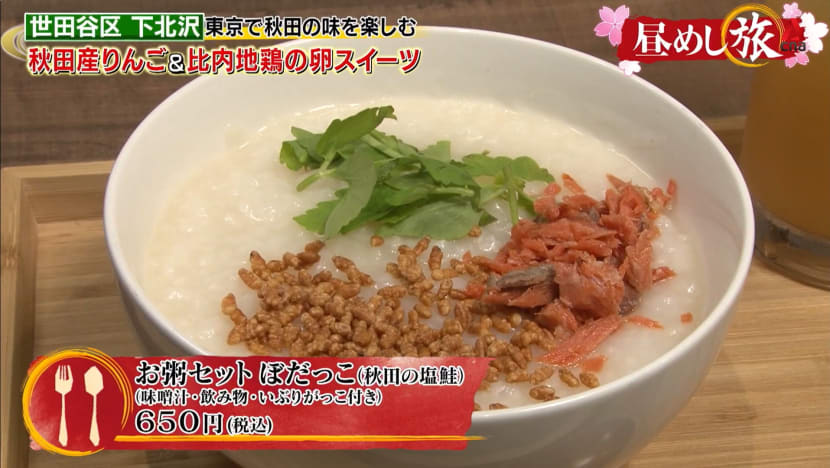It's Lunchtime - Akita Prefecture
Our culinary adventure this week takes us to Tokyo in search of Akita Prefecture’s specialities; dishes include those made with Hinai chicken and even a creamy pudding made with Hinai chicken eggs.

Join us on our culinary adventure in Tokyo to find specialities from Akita Prefecture. Besides the blue Tazawa Lake - the deepest lake in Japan - Akita is also known for its food such as kiritanpo, sandfish, seafood from the Sea of Japan and Inaniwa udon.
Our first stop is a restaurant in Monzen-Nakacho which serves Akita cuisine. Oga Hanto was established in 1979 and we meet the owner Noboru Hori and his wife Kazumi. Mr Noboru is from Noshiro City at the foot of Shirakami Mountains. Noshiro is famous for Tenku no Fuyajo. The annual festival features paper lanterns shaped like castles that are up to 25m tall. It is part of Noshiro’s traditional culture that dates back to the Edo period.
Mr Noboru shows us how to prepare kujirakayaki, a seasonal dish of Akita. It is a typical summer dish made with meat, vegetables from Akita such as onions and aubergines, and edible wild plants like mizu. The soup is kelp based, combined with barley malt and soybean miso from Akita. The meal includes an assortment of other edible wild plants such as bracken served with soy sauce, fiddleheads with sesame miso and mountain udo with vinegared miso.
Mr Noboru tells us Akita is the number one producer of junsai, an edible aquatic plant. It grows in clear spring water and can be found in clean freshwater ponds. Mr Noboru agrees to show us his meal and also what he prepares for the restaurant’s employees. He simmers tuna head meat and later adds sake, mirin, granulated sugar, soy sauce and thinly sliced ginger. He also makes soup using junsai. The broth is made from kelp, dried sardines and a traditional seasoning from Akita Prefecture called Shottsuru. It is served with a light ponzu sauce. Other dishes for the staff include Akitakomachi rice and stir-fried aubergines seasoned with miso from Akita.
Our next stop is Bonus Track, an area in Shimokitazawa, Tokyo with several small businesses. We visit a store called Andon Shimokita. Its owner is Masahiro Takeda - originally from Akita City - who is in his 30s. The store, which opened in 2020, specialises in porridge and sake. Its speciality is porridge made with Akitakomachi rice. It has a gentle flavour of Akita Prefecture’s Hinai chicken. It is topped with bodakko, which is salted salmon from Akita.
The restaurant also sells Namerou, a mixture of horse mackerel and chopped iburigakko. Another item is damako, dumplings featuring ground rice and meat balls made with Hinai chicken. For those who want something sweet, there is Nikkoringo apple juice, made with Fuji apples grown in Yurihonjo. There is also a smooth and creamy pudding made with Hinai chicken eggs and fresh milk. Before we leave Andon, we buy three different kinds of rice balls - bodakko, iburigakko with traditional pickles and cream cheese, and a spicy rice ball with sauteed Japanese parsley and soy sauce.
We next head to a restaurant in Kagurazaka, Tokyo, which specialises in dishes made with Hinai chicken. These chickens are raised in the town of Hinai in Odate City, located at the foot of the Ou mountains. Honke Abeya also has Akita’s local dishes like kiritanpo and Inaniwa udon.
At the restaurant, we meet Yuji Hasegawa, who has been working at Honke Abeya for two years. He shows us how he cooks oyakodon using Hinai chicken. He first simmers the chicken bones for many hours and then seasons the broth with sweet soy sauce from Akita. Hinai chicken has stringy meat and gets hard when it is overcooked, so it is grilled over charcoal to make the meat soft. After the broth boils, he adds egg white and egg yolk is poured in much later. Besides oyakodon, he also makes simmered innards of Hinai chicken.
Mr Hasegawa also cooks meals for the staff. Dishes include seasoned Akitakomachi rice, Hinai chicken breast and thigh meat cooked in foil and one of Mr Hasegawa’s original dishes, called tamamiso, featuring miso paste combined with eggs. He often comes up with new dishes for employees’ meals. Another dish of his is cabbage stuffed with meat balls made of ground Hina chicken and green onions. He uses soy sauce and mirin for seasonings and bonito for the broth.
Tips:
1) Hinai chicken is a must-try speciality of Akita Prefecture
2) Noshiro City is famous for the Tenku no Fuyajo festival with castle-shaped lanterns












